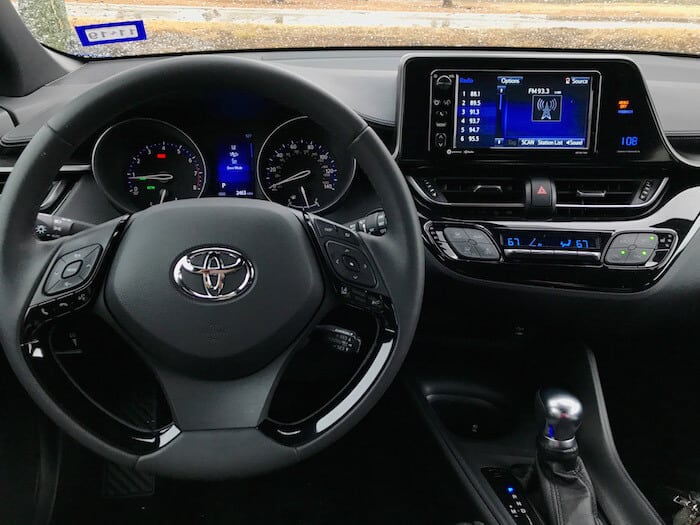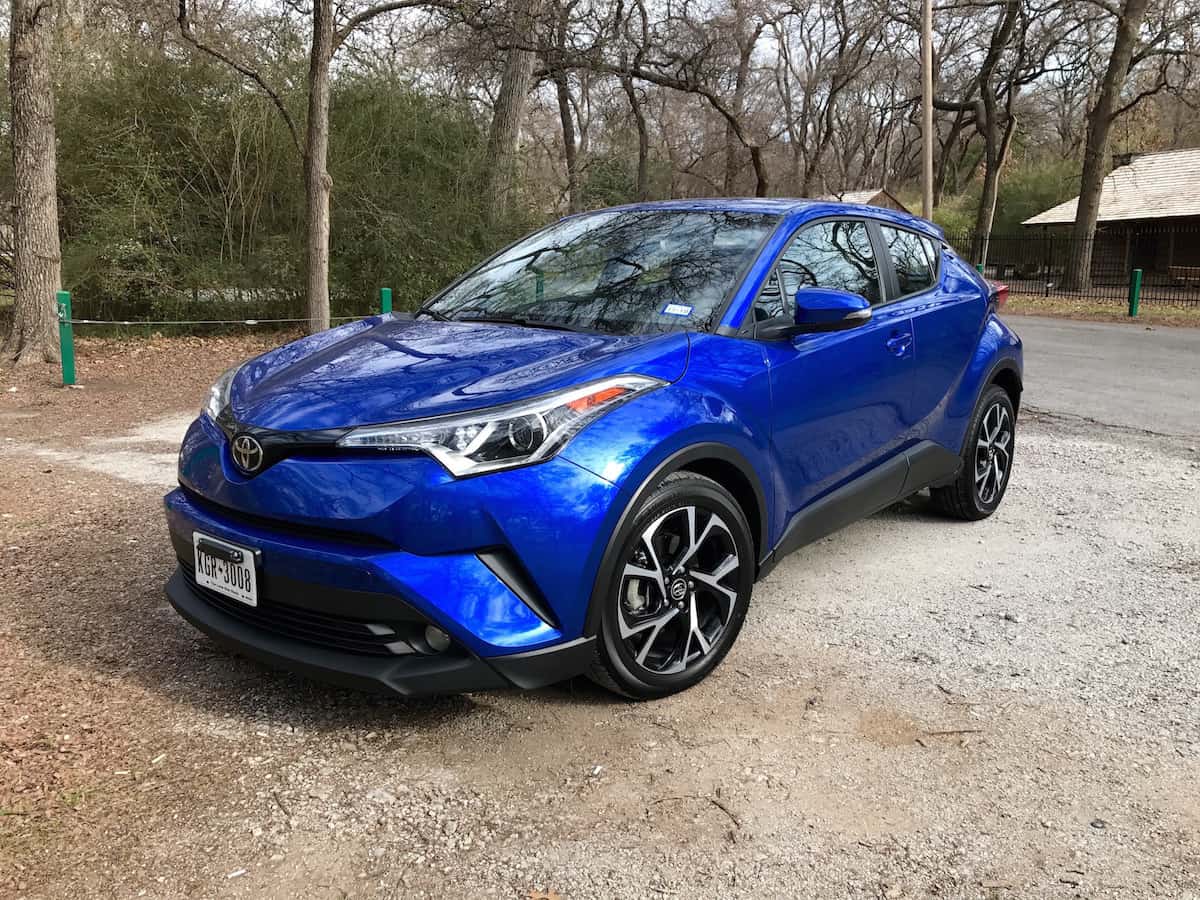Allow me to introduce you to the 2018 Toyota C-HR, Toyota's delayed entry to the subcompact SUV segment. Designed to give off a, shall we say, "youthful" vibe, I dialed back any preconceived notions I might have had only to make a surprising discovery. The C-HR succeeds in being a fun to drive compact crossover. However, there are some head-scratchers. While it's loaded with standard safety features, it lacks other features and upgrades offered in other small SUVs.
2018 Toyota C-HR
The 5-door C-HR, aka "Coupe High-Rider", is part SUV part hatchback and comes in two trims, the XLE and the XLE Premium. Both equipped with 18-inch alloy wheels. Its heavily sculpted styling is attention-getting, edgy and you either like it or you don't. (I liked it.) Unfortunately, the edginess gets in the way of safety. Take the rear door handles. They're hidden high up into the doors near the roofline, a design that creates a thick rear pillar that both cuts into rear passenger window space and impedes visibility in the blind spot. I was also surprised to see it equipped with halogen headlights. These days, LEDs and HIDs are replacing halogens according to the Insurance Institute for Highway Safety. (The C-HR does come with LED daytime running daylights.)
Cabin Is a Mixed Bag
To love the C-HR you have to love a stark black interior because it's the only option for either trim. It's pretty dark in there, with all black surfaces and a glossy black lint-attracting trim around the 7-inch touchscreen and dual climate control area. Toyota does attempt to make things a little more interesting with some diamond-patterned surfaces. The XLE's sport-bolstered heated front cloth seats are comfortable, but if you're hoping to upgrade to some sort of leather, you can't. Also, the XLE Premium only offers power lumbar support. All other seat adjustments are manual. The dash is soft to the touch, along with a leather-trimmed tilt/telescopic steering wheel and gear shifter. The XLE Premium comes with push-button start. The tachometer and 4.2-inch driver display screen are standard Toyota. I enjoyed using the voice-activation system, which performed well for me. The C-HR gets my thumbs up for cabin ergonomics. The steering-wheel-mounted controls and center console buttons are shaped to fit your fingers as they naturally fall diagonally when reaching for the controls. The touchscreen and console area is also slightly angled towards the driver's seat for easier viewing. However, don't expect to pull up a camera view there. The rearview camera is integrated into the auto-dimming rearview mirror. A standard electric parking brake with a brake-hold feature is also a plus. It's roomy in both the front and back and features a 60/40 split fold-flat second-row rear seat with adjustable headrests. Cargo room is fine.
It's Slow But Handles Great
The C-HR's powertrain is one of its weaknesses. A 2.0L four-cylinder engine delivers 144-horses but it could stand a few more given the C-HR's 3,300 lbs. Acceleration can be sluggish. Then there is the matter of the noisy, droning CVT equipped with a manual mode. The combo delivers 139 lb-ft of torque. On the upside, boy did the C-HR's handling surprise me. This thing is fun to drive. Toyota did a great job with the newly developed MacPherson strut front suspension. The C-HR is firm and nimble on its feet with confident, precise steering. That said, one thing could be a deal breaker for some people. The C-HR is front-wheel drive only, putting it at a disadvantage to the competitors like the Mazda3, Honda HR-V, and Subaru Crosstrek.
What Else You Don't Get
The C-HR is also missing any kind of navigation option. There is also no Android Auto or Apple Carplay. It also doesn't come with or offer a moonroof.
Safety Features
You can't argue the fact that the C-HR shines when it comes to safety technology. You'll be hard-pressed to find more in its class for the price point. The Toyota Safety Sense P (TSS-P) package comes standard on even the base model. It includes a pre-collision with pedestrian detection, automatic emergency braking, lane departure alerts with steering assistance, and automatic high-beam headlamps. Plus, you even get adaptive cruise control which can bring the C-HR to a full stop in traffic. The XLE Premium trim is the only model with Blind Spot Monitoring and Rear Cross-Traffic Alert. The C-HR also receives a Toyota-first feature: Driver Distraction Secure Audio (DDSA). It prevents certain multimedia menus from being selected while the vehicle is in motion by complying with NHTSA’s Driver Distraction Guidelines.
Fuel Economy and What You'll Pay
The C-HR's delivers the good fuel economy you expect, delivering 29 combined miles to the gallon. The base model starts from $22,500 and the Premium XLE takes you to $24,350. Add in delivery and handling and my tester's MSRP ends up at $25,345. At the end of the day, if standard safety features are important to you along with edgy styling and a fun to drive ride, the C-HR could be for you. But if you want all-wheel drive, navigation, and upgraded seating options you'll need to look elsewhere.
2018 Toyota C-HR XLE Premium
- What I liked most: Its fun to drive handling.
- What I would change: Lighten up the dark interior and add some horsepower.
- MSRP: Base price $24,350, as equipped $25,345.
- Fuel Economy: 27 City/31 Highway, 29 combined.
- Fuel Tank: 13.2 gallons of regular fuel with filler on the driver's side.
- Dimensions: 171.2” long/70.7” wide/61.6” high.
- Weight: 3,300 Pounds.
- Trailer Towing: NA
- Miles When Tested: 2,353 miles.
- Official Color: Blue Eclipse Metallic.
- Spare tire: Temporary spare.
- Final Assembly Point: Arifiye, Sakarya, Turkey.
- 2018 Toyota CH-R in a few words: A get-you-noticed fun to drive ride packed with safety features.
- Warranty: 3-year/36,000-mile Comprehensive/5-year/60,000-mile Powertrain/5-year/unlimited-mileage Corrosion Perforation
- Manufacturers website: Toyota














